Dear Azami, This one is a love story. I started off by asking what color identity she wanted to be. She loves green for its beatdowns, the purity of white, and the control aspect of blue. “Turquoise! That should be the name of this deck,” said my wife Lauren. Although the name ended up being Rafiq of the Many Ways to Kill You, it is definitely sleeved in—you guessed it—turquoise Dragon Shields. I have been trying for two years now to get my wife to consistently play what is surely the world’s favorite pastime—Magic: The Gathering. We have been married for three years, and believe it or not she knew about my Magic addiction beforehand. She told me that if she was going to play, she would have to be the one to build the deck. She sat down and went through each of my boxes and binders, collecting a nice pile of cards and then putting together her 100. I was allowed to look it over and make some suggestions. It was pretty scattered. No offense to my wife, but if I have learned anything from your articles, it is to have a plan and stick to it. Cutting to the chase, this deck doesn’t know how to win. It has made 80 Soldier tokens, four million Squirrel tokens, and won with Archangel of Thune and Voltron Auras. It has won with Biovisionary. The problem the deck has is that it is not consistent (a running theme in our Magic relationship) and loses fairly easily to control and aggressive decks. My wife is not happy about it. Commander Creatures (20) Eidolon of Countless Battles Planeswalkers (3) Ajani, Caller of the Pride Artifacts (5) Bident of Thassa Spells (38) Thassa, God of the Sea Lands (33) 3 Island Brion Stoutarm and Melek, Izzet Paragon are the decks we see every game night. The usual winners I should say. Please help me out. As they say, “A happy wife is a happy life.” –Sean |
I think the biggest issue we are facing here is that you and your wife are trying to build “not that Rafiq deck.” You know the one I am talking about—the one that is designed to deal 21 commander damage in one swing the same as every other Rafiq deck you usually see. In trying to be different, Lauren’s deck has moved over into an Enchantress strategy and lost a lot of focus. I see a lot of two-card combos that otherwise don’t do very much unless the other half is also drawn, like Biovisionary plus Rite of Replication and Earthcraft plus Squirrel Nest. As memorable as it may be when the combo comes up and suddenly four million Squirrels spring into existence or you win the game with Biovisionary, the rest of the time these cards are not going to do very much at all.
The Enchantress theme is strong here, but I am not sure it is the right fit for the deck. I like some of it enough to keep it around in pieces, but overall I think this is trying to pull away from what Rafiq is good at—making a double strike attacker—in order to be different. I have no problem being different—if I just wanted to build that very same Rafiq deck, I doubt I’d have chosen your submission this week—but I think the better way to be interesting, fun, and different against your expected opposition of high-caliber Melek and combat-oriented Brion would be to focus not on Rafiq’s damage output (boring!) but instead on how double strike leads to double the triggers for any “when this creature deals combat damage to a player” effects your creatures may naturally generate or otherwise have stapled to them.
This is far more intriguing design space, and maximizing it requires us to cut out huge chunks of what Lauren’s deck has going on in order to make it work. We’re going to end up with a mix of enchantments and Equipment to do this, so the Enchantress theme is going to be weaker than it is in the current inception of the deck, but I still think many of the enabler cards are going to be worthwhile, meaning the deck should be recognizable from its origin point. We’re just going to pare down to the essentials before we build back up again around what worked and what the new plan is.
This is also going to require us to shift the deck’s balance overall, as Rafiq needs a buddy to work with and thus we’re going to need a bigger creature base than Lauren’s current build has. We’re short on lands too—I think 36 lands plus Sol Ring are needed for even an aggro build of the deck. I don’t know how the current version would ever get to the nine mana needed for Rite of Replication’s kicker or an entwined Tooth and Nail anywhere close to on time.
My “theory of deckbuilding” in this format is that you as a player have relevance only insofar as the spells in your hand give you things to do, which means card draw is very important along with being able to cast the spells you draw. Having a grip full of nine-drops while you’re stuck on seven lands is a critical failure of the overall planning phase, and we’re going to carve out chunks of the deck based on the desire to maintain relevance. In many ways that means cutting back on things that cost us card advantage or things that are unfocused.
The Cutting-Room Floor
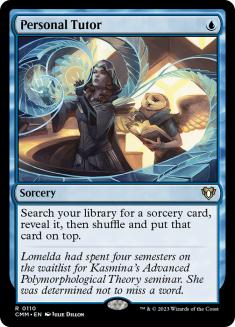
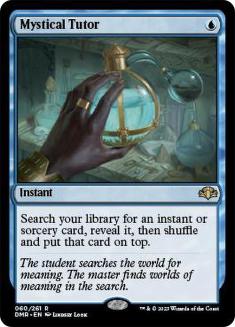
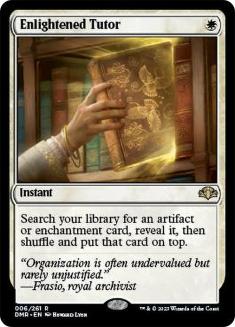
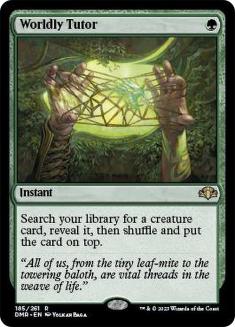
One of the easiest ways to fall behind is to use these types of tutors in order to find the “best” card or the “right” card. Skipping a draw to tutor is dangerous, as that card you’re drawing now has to be worth multiple draws. If instead of seeking the “optimal” card you draw more cards and that batch of cards by design includes an answer to the problem you face, overall the deck will just work better.
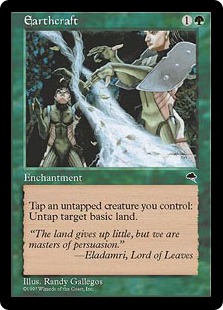
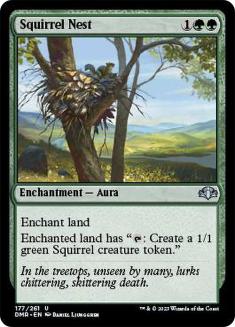
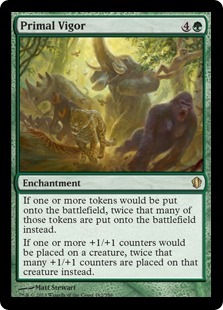
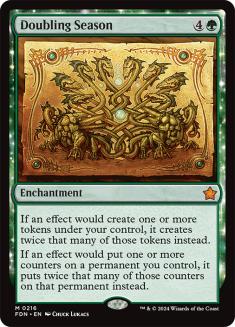
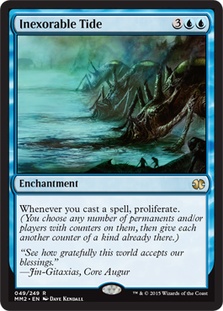
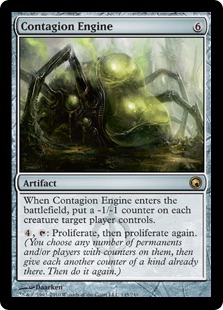
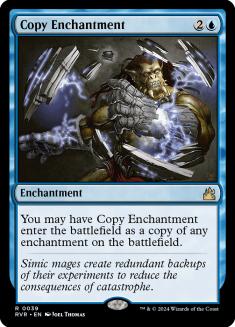
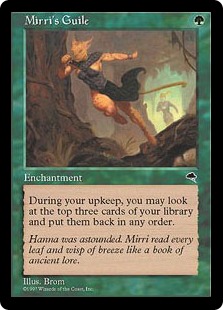
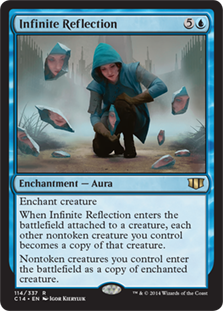
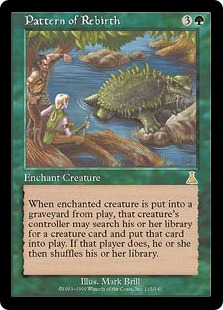
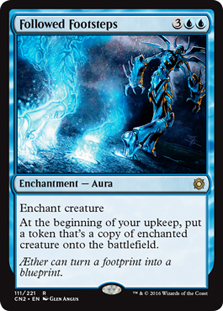
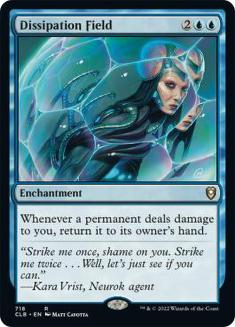
The question here is what are we proliferating or otherwise doubling with all this counter manipulation? The answer doesn’t appear to be very much, with just three planeswalkers in the deck and not actually that much in the way of +1/+1 counters to manipulate here. Infinite Reflection seems like another card to combo with Biovisionary but has the unfortunate side effect of turning all your powerful creatures into Biovisionary. Other than that combo there aren’t really any good uses for the card with the creature set you have or clear benefits to maximizing its use (though I suppose turning every future Squirrel into an Angel of Serenity may be awesome enough to overcome my naysaying, that combo is a little too specific for me to really want to keep this card around).
The other cuts here are based on the fact that a lot of best case scenarios are going on—without sacrifice outlets, Pattern of Rebirth is pretty easy for an opponent to work around via bounce or exile effects, while Dispersion Field can either dissuade an opponent from attacking you or advertise that you’re the person to swing into if they want to rebuy an enters the battlefield trigger. It’s bad enough getting hit with Terastodon once. You don’t really want to set up a mechanism by which this loop keeps repeating itself thanks to your own enchantment. I’ve seen this particular one hurt about as often as I’ve seen it help.
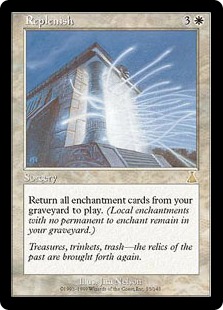
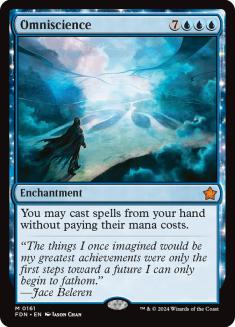
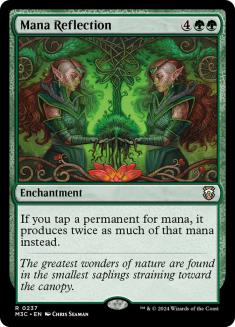
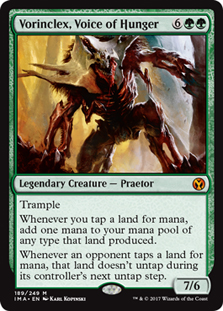
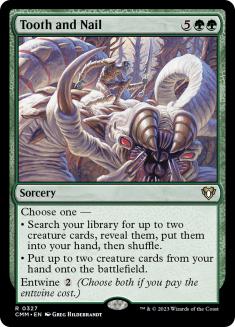
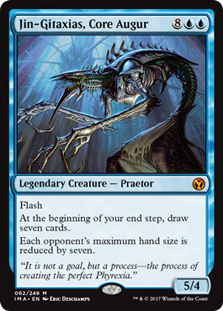
Mana Reflection we’re cutting and replacing with a somewhat cheaper version of the same effect, mostly because the “double” utility is basically the same as “+1 from any land” in this deck and five is much easier to afford at a reasonable pace than six is. Six is right around the top end for this deck’s mana base, so getting to the peak just to double your access from there isn’t that helpful. And Omniscience is right out—it’s basically uncastable, and all it does even if you do manage to cast it is make all of your cheaper cards free when you can already afford them. Vorinclex is more reasonable since it costs eight, not ten, but still isn’t what we are trying to accomplish. Doubling your mana doesn’t really do that much for you in this deck.
Replenish and Tooth and Nail are cuts based on how the deck is built—there are no two “strong” creatures to get off of Tooth and Nail, at least not enough to warrant spending nine mana when you can’t realistically expect to be able to afford it until very late in the game, and Replenish is going to have considerably fewer enchantments to work with and thus be of less use to us by the time we get to the end of things here.
Jin-Gitaxias gets cut for costing ten and being about the most un-fun card ever since it is designed to cripple your opponents and give you all of the spells, which is to say it ends the game without the good judgment of allowing the game to actually end at that point. You get to spend the next five minutes watching your opponents discard their hands and then draw a card for the turn dejectedly for however long it takes you to kill them with plus seven cards each turn. While admittedly that shouldn’t be very long, that’s also not Magic and thus not a fun game of Commander to play for anyone.
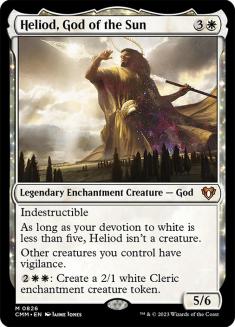
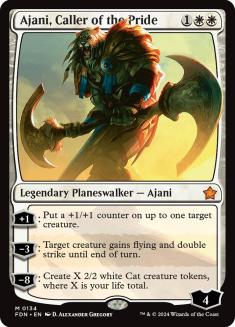
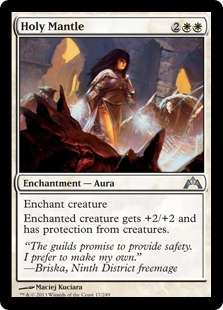
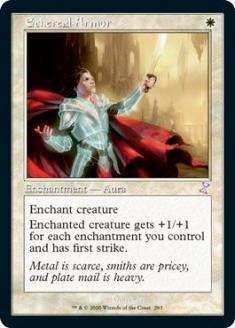

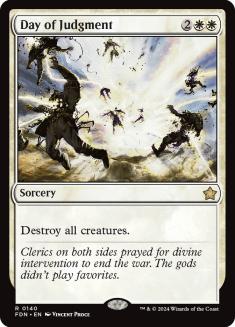
Heliod simply asks for too much mana to do not enough stuff—we’re very unlikely to be able to attack and block with him, and four mana for a 2/1 is just not that worthwhile to us when your commander maximizes its benefit by finding a single creature to attack with alone. Ajani gets cut because I’m not confident the +1/+1 counters would be better than just an enchantment or Equipment to provide a creature buff and the “to the air!” mode spends a lot of cardboard that is already overlapping with Rafiq’s important exalted trigger. When things are going at their best, Ajani’s trigger is most of his starting loyalty for just flying for a single turn or a slow power bonus that might be better served with an enchantment that your opponents aren’t allowed to just attack and kill.
Holy Mantle I like in concept but not in actuality. I found a replacement I think you’ll approve of. Ethereal Armor is a mana-efficient buff for an enchantment-heavy deck, but I’d rather spend a bit more mana and get more bang for my cardboard if possible. First strike is good, but it’s not an actual evasion ability like trample, flying, or unblockable/protection from creatures would be. And the sweepers are just not the best ones you have access to in this format. I think the number of them is about right but not their unique identities, so we’ll be upgrading them, not merely cutting them.
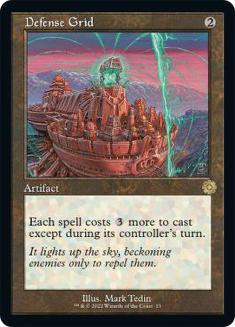
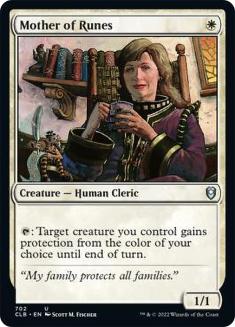
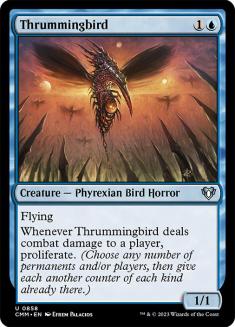
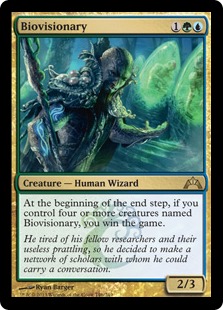
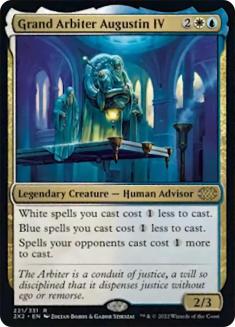
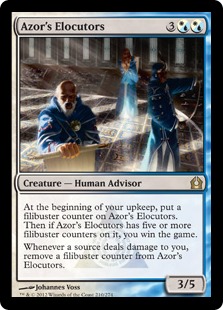
Defense Grid is not really that important—it doesn’t sound like counters are a big enough deal that you need to play a card in order to try to negate the— and the remainder are all your weakest (or most aggravating) creatures. I have to imagine that the main use of Azor’s Elocutors would be to proliferate your way to victory, which sounds marginal at best, and like Biovisionary this is another one of those two-card combos where we’ve cut the other half of out of the deck. Thrummingbird goes the way of the dodo like other counters matter cards because frankly I don’t see the counters mattering that much.
Grand Arbiter gets cut mostly for frustration reasons. It’s a highly polarizing card that will create much more angst (and thus much more people target you for reprisals) than the benefit of a few mana saved will provide. Like Vorinclex, there are benefits to be had from keeping it around, as it will accrue you an advantage, but the disadvantage inflicted by the card is so much larger by comparison that other players would be well justified in wrecking your stuff immediately and will probably keep doing so long after the initial threat to them has passed.
Mother of Runes we’re cutting because it is in need of an upgrade—it’s effective because it is cheap for what it does, but we need to scale that ability up on an industrial level, which means replacing it with a card that is able to work harder by trading mana for protection instead of the tap effect that otherwise limits it to one use per turn cycle.
But then we also have some mana fixing to do.
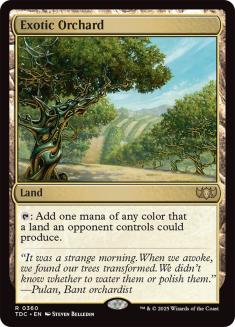
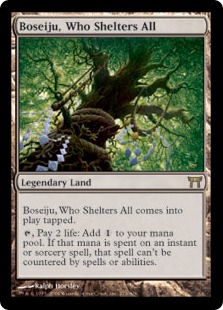
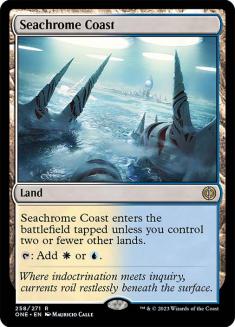
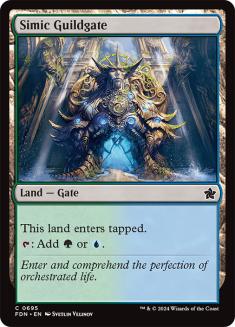
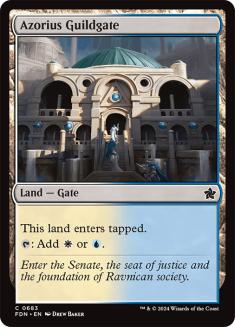
Building A Better Monster
Those five lands were cut because of inconsistency—four out of five of them come into play tapped in almost every scenario, one of which doesn’t ever tap for mana without hurting you and only provides colorless mana. The tradeoff is supposed to be that it makes your big stuff uncounterable, but a good portion of your big stuff was already an enchantment or a creature so it wasn’t even doing that job particularly well.
The fifth, Exotic Orchard, may be as good as Command Tower or may be a Blasted Landscape you can’t cycle, stuck tapping for colorless when your deck is fairly color intensive. The most likely outcome is that it’s a dual land whose colors you don’t get to pick before the game starts, and the best outcome of it just tapping for all three colors may happen a lot. But I tend to avoid the land simply on the principle of wanting to be able to choose how my mana works in advance of the game starting so that I always know it will work consistently. This is a random chance factor I try to minimize and thus tend to avoid.
We’ve cut five lands, but I will be adding eight back in, mostly completing the cycles I have seen added to the deck so far. I saw two out of three Temples for example and two out of three Ravnica dual lands, so Temple of Plenty and Temple Garden both make sense, completing the cycles. I saw Celestial Colonnade but not Stirring Wildwood, so its companion dual land will also get added even if it is not quite as flashy as the Colonnade—all five of them can’t be the best one of the cycle, and this one is still pretty good.
Okina, Temple to the Grandfathers has a useful ability that we might want for free stapled to our Forest so we’ll add it as well, while Krosan Verge is too good to pass up, especially in a deck that is otherwise expecting to play off of just the mana you draw without any ramping to supplement it. Having a land that both ramps and color fixes is pretty sweet—as long as you’re both green and white already, it’s like getting to play an extra bounce land as far as the part of them that is like drawing a free land is concerned.
Two more basics—one Plains and one Island—round out the bunch, with one slot as yet unfilled. The last one I picked based on the shape of the overall plan. You’re going to use Rafiq to attack for damage increases anyway so a spare exalted trigger will be worthwhile as a value-added bonus, and that is an option we’re allowed to select by adding Cathedral of War in the last slot.
We’re at the point where I start to worry we have too many lands coming into play tapped—twelve out of 36 means one out of your first three lands should come into play tapped, and you’ve likewise got a 33 percent chance of any land you draw off of the top coming into play tapped when you’re trying to hit your higher drops—but we’re going to build the deck so as to supplement our normal draws with some bonus card draw all focused around the three-mana mark, so I am confident that we won’t trip over our own feet too often even with this many lands coming into play tapped.
Usually I move to the artifacts after I work on the lands under the logic that they’re a natural extension of a deck’s mana-generating capabilities. In this specific case, that’s quite false. We’re going to add four Equipment cards, and your deck’s mana-generating artifacts are limited to Gilded Lotus and Sol Ring, which is quite sparse compared to the usual pile of Signets, Ingots, and Relics that can often be found in this space. I don’t really like mana rocks anyway but do want to focus on combat damage triggers, and we’re selecting our reusable creature buffs accordingly.
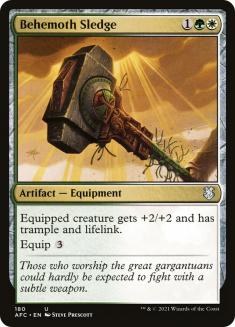
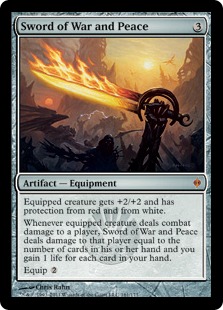
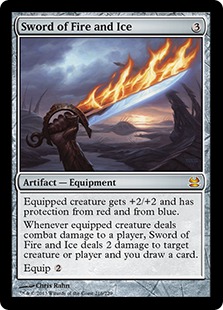
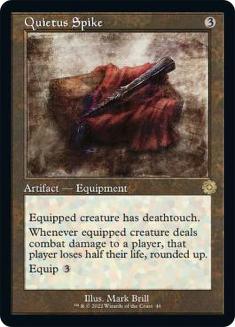
Behemoth Sledge granting trample is actually very valuable to us since we want to hit an opponent when we tap to attack, and the lifelink ability is basically a combat damage trigger of the sort that we’re trying to maximize anyway (even if it is less specific and doesn’t care whether you’re punching a wall or somebody’s face unlike most of the rest of our triggers). Quietus Spike is dangerous indeed on a double strike attacker, as the deathtouch makes it impossible to square off against that creature in a fair fight, and if it should get through unblocked, dealing your power’s worth of damage followed by losing half of your remaining life and then repeating this process is an awful huge life swing.
Let’s say it’s a humble 2/2 we’re attacking with, granted +1/+1 by Rafiq’s exalted ability, and our opponent has bloated themselves up to 100 life. First we knock them to 98, then to 49, then to 47, and then to 24. Suddenly our 2/2 attacked for 76 damage. That is an awful lot of bang for your buck, and it gets even better the more people try to use life gain to get out of range.
The two Swords are the best combat damage triggers to try to multiply, though frankly any Sword of X and Y would be good. Sword of War and Peace is a nice damage multiplier, kind of like Quietus Spike except that it punishes card gluttons instead of habitual life gainers, while Sword of Fire and Ice is ideal for its card draw trigger—the pair of Shock you get for free is just a bonus when considering the card. Sure, it’ll provide a bit more damage, but nothing like the damage output we get out of the other Equipment we’ve added.
Moving on to the spells next, we have five Auras to add back in and the replacement for Mana Reflection that I’ve promised as well as replacing the sweepers with their best versions for the Commander format. The remainder will be pinpoint removal as supporting cast since you’re playing without any countermagic whatsoever and are currently quite light on ways to affect an opponent’s board should things not go quite your way.
The two sweepers are going to be Austere Command—ideal for hitting your opponents’ side of the board while leaving your own intact and able to answer a wide variety of problem permanents—and Rout, which plays much like Day of Judgment but has the added ability of being playable at instant speed if you want it to be, a considerable benefit in a deck that plays as few instant speed cards as this deck. Our support cards are going to be Path to Exile and Swords to Plowshares for when we really need something dead right now with no negotiation. We don’t want to overload on one-for-one exchanges, but having one-mana answers that can solve virtually all problems is a very good idea when you’re playing a proactive deck like this one is building up to be.
We cut all of the Mirage style tutors but left Idyllic Tutor since it puts the card right into your hand, and there is a second tutor card we can play that has the same upsides—more than one if you want to consider Fabricate for an Equipment card (which we’ll be skipping). Eladamri’s Call is one of the clearly awesome cards you get when you pick green and white together (and are playing creatures I guess). It wasn’t the tutoring I was against but the card disadvantage to do so—Eladamri’s Call maintains card parity and thus is well worth including here.
And we cut Mana Reflection but promised a replacement, which brings us to another one of the Selesnya superpowers: Mirari’s Wake. Five mana is potentially several turns of waiting cheaper than six mana in this deck. We’d be happy to get the +1/+1 buff to our creatures anyway and are getting it alongside a full mana’s discount here, and the distinctions that Mana Reflection makes—”double” instead of “+1” for our bounce lands plus increasing your mana from any permanent instead of just a land is not that relevant to our interests—aren’t worth the extra time spent waiting for it to deploy. Five mana is about the limit where we’d still be interested in the effect. If there was no five mana or less option, I’d just cut the card, but since we have access to an efficient replacement that doesn’t ever share with our opponents, we’re happy to run it instead.
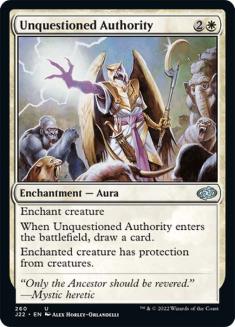
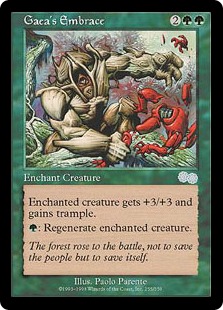
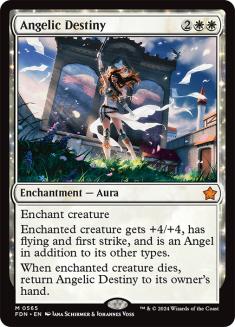
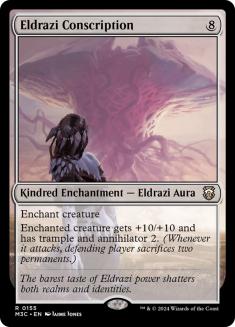
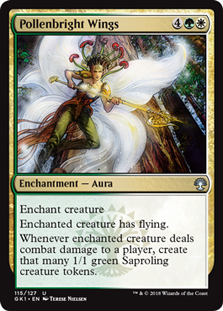
Unquestioned Authority doesn’t give a power bonus, but it does immediately replace itself, which I consider a much stronger effect than a small generic bonus. I didn’t like Holy Mantle because it wasn’t worth the card—we’ve taken that downside out of the equation, so I’m happy to get to keep the effect. Angelic Destiny gives us evasion and a huge size boost while returning to our hand if the creature dies and basically struck me as the ideal version of the effect we were trying to generate with Ajani, Caller of the Pride anyway and at a comparable cost.
Eldrazi Conscription is a huge boost that comes at a huge price as well, but we will have at least one card that will try to cheat on that price and will pay us back for including the card in our deck. And sometimes you just draw it, cast it, and kill someone dead—it’s true that we’re trying to avoid ever spending eight mana on a card, but this alternate mode of “actually drawing it” is one we’ll still be able to access enough of the time that it’s worth including the variance that comes from drawing it and being stuck with it a while. Gaea’s Embrace is a powerful buff as well—it grants a considerable size increase plus trample as well as offers regeneration as a means to protect the creature from the mundane removal that you can expect to see multiple times over the course of a normal game.
Our last Aura added is the one I was most pleased to find, as I’m trying to incorporate more cards that trigger off of combat damage and preferably in a more offense-oriented way than the defensive abilities already offered by Celestial Mantle, the Aura I saw in the original deck that most inspired me to try and shift the build more in this direction. Pollenbright Wings grants evasion, yes, but no power bonus. So for six mana we’re looking at flying so far, and we are not impressed.
The other five mana going into the card is an effect very similar to that of Rith, the Awakener, and if you’re dealing a lot of damage thanks to power boosts and double strike, this is a considerable token army to recruit to your side, far more than Squirrel Nest could provide without Earthcraft to turn it infinite and thus far better aligned to the strengths the deck is building toward instead of relying on cards that are only good if you draw the other half of the narrow combo.
Team Red Zone
Every card we add from here will be a creature, boosting your overall count by nine cards (eight if you consider Heliod a critter, which you did not in your write-up above). A fair chunk of them are going to pay attention to the fact that Rafiq can be very curve conscious—a two-drop or three-drop can be followed up by Rafiq immediately amplifying their benefits, so the kinds of cheap creatures that are usually not so good in Commander can be real powerhouses here because of mana curve concerns. Sure, it’s not better to draw a three-mana creature on turn 17 when everyone’s board is empty and there’s a pile of mana available to everyone, but it is better to draw at least one three-mana creature by turn 3 so we are going to have to play a fair number of them then.
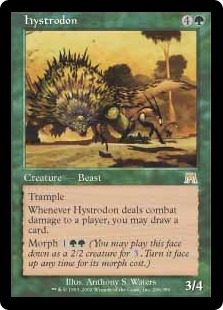
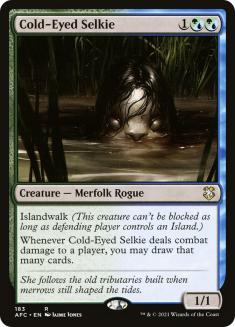
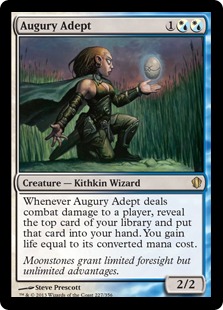
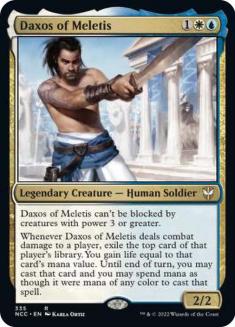
These four creatures complement the deck’s card draw capabilities and alongside Rafiq can potentially put two or more cards in your hand each turn in one form or another. Daxos is arguably the weakest of them since it pulls opponents’ cards and doesn’t let you play any lands you may get from them, but he makes up for it by potentially gaining a huge chunk of life and letting you access powerful spells that you didn’t actually include in your own deck. I am a big fan of using other people’s resources, and Daxos adds a little extra flavor to the otherwise boring card draw game.
Augury Adept and Hystrodon are the “normal” versions of this effect for us. One of them gains us life while the other potentially offers trample built in to make sure we get through, and both are quite solid if otherwise unremarkable. Cold-Eyed Selkie however is a special one—you get a card not for damaging your opponent but for each damage, so we can very easily go entirely crazy as its evasion ability is the surprisingly potent Islandwalk and with Rafiq we’re already looking at drawing four cards on turn four even before accounting for any other buffs we may be able to obtain. In the late game while packing an Equipment or a couple of enchantments, this can easily go to a ludicrous place, and I think we should go there.
Our other cheap additions are Trygon Predator (who wouldn’t like doubling up on a threatening Disenchant effect?), Eight-and-a-half-Tails to replace Mother of Runes, Spawnwrithe to potentially get a huge jump in the early stages of the game, and Rootwater Thief for a bit of deck surgery as a combat trigger. I wouldn’t have added the card had it not been able to also give itself an evasion ability, as having to pay mana for the triggers makes it less appealing to us, but the people who will get beat by hitting them with the Thief deserve to get bashed with the card.
And against fairer decks it can still give a lot of tactical options that allow you to build a longer-game plan. It will be underwhelming when facing fair decks but will absolutely shine against the worst combo deck offenders, and we can deal with some situational card quality as long as the body is decent enough to build off of later on if we need something to hold a Sword or two.
Spawnwrithe can potentially grow far out of hand very early on—playing it turn 3 and then granting it double strike and attacking puts three into play, after which we forego the exalted trigger and attack with all of them each turn. It’s a powerful early creature that can dominate the board even without the potential for Rafiq to boost it and is well worth including even though after the first attack it starts working counter to Rafiq’s natural preferences.
With ten creatures we can cast before Rafiq, we’re very likely to draw one in our opening turns, even though some of them might not be exactly ideal for just casting on turn 3 (I’m looking at you, Eternal Witness and Eidolon of Countless Battles). That gives us the natural curve of some creature on turn 2 or 3, Rafiq on turn 4 to pump it early, and then an Equipment or Aura card on turn 5 to further double up with Rafiq’s double strike exalted trigger. This is a pretty strong sequence of plays, bringing the deck’s plan further into alignment overall while not necessarily becoming boring since we’re trying to optimize the combat damage triggers of other cards rather than gun Rafiq for 21 commander damage as fast as possible.
For the rest of these slots, I was willing to go further up the mana curve as long as I got an impressive amount of bang for the mana and it worked well with Rafiq. This naturally sorted the remaining slots into “things Rafiq is maximizing” and “things that otherwise help,” as they either provide a combat damage trigger or are otherwise some kind of cheerleader.
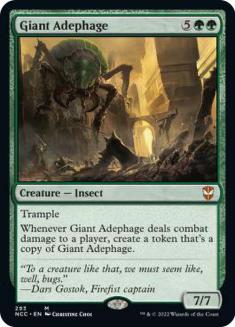
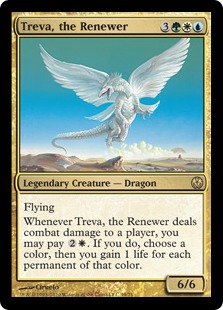
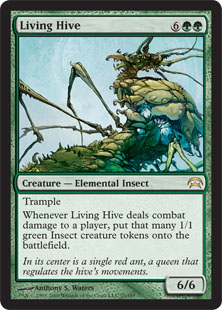
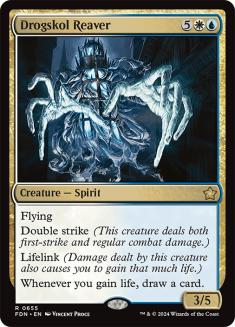
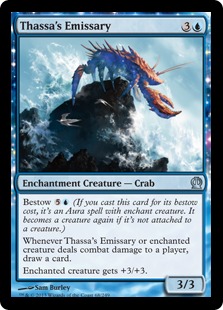
Giant Adephage is the 7/7 Spawnwrithe, and that includes all of the same tensions with Rafiq that come alongside the fact that after the first turn’s damage increase from your commander, it suddenly wants to attack with all of its friends instead of hang back and be Exalted. Again, the benefit is well worth the synergy breakdown, and I think it’s a card we should be seeing more of in Commander than we are since I like cards that by themselves generate an army in a can.
Living Hive is likewise disgusting because it effectively comes with Pollenbright Wings strapped to it already, able to disgorge a huge token army onto the table in a single attack. Treva’s trigger is “just” life gain, my least favorite thing to maximize, but it’s still a worthwhile thing to double up on when attached to a Dragon-sized creature. Would I rather have Dromar, the Banisher’s trigger? Yes. Can I get it? Next question.
Drogskol Reaver goes well alongside all of this life gain and is an impressive creature with any of our buffs even without Rafiq thanks to coming with double strike built in. And Thassa’s Emissary can likewise help with the card draw. We would prefer a card that costs three or less but have run out of the “good” ones already, and when you move up to four mana, you gain the bestow ability as a tactical option for later in a deck that already cares about both enchantments and creature buffs, making it the best of both worlds on a creature that has legs of its own if we just want a four-drop.
The last three cards are our cheerleaders: Sovereigns of Lost Alara, Battlegrace Angel, and Stonehewer Giant. Battlegrace Angel lends another plus one power through the exalted ability and turns any of our attacking creatures into a life gain vehicle, which should help make up for the fact that we’re a bit weak overall on defense thanks to our aggressive stance, and is a natural fit at the five-drop following up an earlier creature and Rafiq.
The last two are there to provide us more free creature buffs. Stonehewer spits out the right Equipment at instant speed, while Sovereigns of Lost Alara can play on the table and crank out any of the Auras based on what we need in the moment, from Unquestioned Authority (and a card in our hand) to Eldrazi Conscription (and an opponent in a whole lot of trouble). With eight Auras still in the deck to choose from, surely there will be one that matches the needs of the situation since we’ve included a strong mix of options to choose from.
Putting it all together, we get the following deck:
Creatures (31)
- 1 Eight-and-a-Half-Tails
- 1 Eternal Witness
- 1 Living Hive
- 1 Hystrodon
- 1 Rootwater Thief
- 1 Treva, the Renewer
- 1 Celestial Ancient
- 1 Trygon Predator
- 1 Stonehewer Giant
- 1 Augury Adept
- 1 Spawnwrithe
- 1 Cold-Eyed Selkie
- 1 Battlegrace Angel
- 1 Rafiq of the Many
- 1 Stoic Angel
- 1 Sovereigns of Lost Alara
- 1 Kozilek, Butcher of Truth
- 1 Drogskol Reaver
- 1 Avacyn, Angel of Hope
- 1 Bruna, Light of Alabaster
- 1 Angel of Serenity
- 1 Giant Adephage
- 1 Aetherling
- 1 Archangel of Thune
- 1 Thassa, God of the Sea
- 1 Daxos of Meletis
- 1 Thassa's Emissary
- 1 Prophet of Kruphix
- 1 Medomai the Ageless
- 1 Archetype of Endurance
- 1 Eidolon of Countless Battles
Planeswalkers (2)
Lands (36)
- 2 Forest
- 3 Plains
- 4 Island
- 1 Okina, Temple to the Grandfathers
- 1 Sungrass Prairie
- 1 Skycloud Expanse
- 1 Krosan Verge
- 1 Selesnya Sanctuary
- 1 Temple Garden
- 1 Azorius Chancery
- 1 Breeding Pool
- 1 Hallowed Fountain
- 1 Simic Growth Chamber
- 1 Mosswort Bridge
- 1 Mystic Gate
- 1 Wooded Bastion
- 1 Flooded Grove
- 1 Seaside Citadel
- 1 Glacial Fortress
- 1 Sunpetal Grove
- 1 Celestial Colonnade
- 1 Stirring Wildwood
- 1 Command Tower
- 1 Hinterland Harbor
- 1 Gavony Township
- 1 Alchemist's Refuge
- 1 Cathedral of War
- 1 Temple of Mystery
- 1 Temple of Enlightenment
- 1 Temple of Plenty
Spells (31)
- 1 Swords to Plowshares
- 1 Sol Ring
- 1 Mirari's Wake
- 1 Enchantress's Presence
- 1 Sword of Fire and Ice
- 1 Gaea's Embrace
- 1 Gilded Lotus
- 1 Eladamri's Call
- 1 Rout
- 1 Unquestioned Authority
- 1 Pollenbright Wings
- 1 Privileged Position
- 1 Austere Command
- 1 Idyllic Tutor
- 1 Steel of the Godhead
- 1 Quietus Spike
- 1 Path to Exile
- 1 Sigil of the Empty Throne
- 1 Finest Hour
- 1 Behemoth Sledge
- 1 Wargate
- 1 Celestial Mantle
- 1 Rite of Replication
- 1 Eldrazi Conscription
- 1 Leyline of Anticipation
- 1 True Conviction
- 1 Sword of War and Peace
- 1 Angelic Destiny
- 1 Sphinx's Revelation
- 1 Bident of Thassa
- 1 Aqueous Form

As always you and your wife will receive $20 store credit to StarCityGames.com to put toward this deck, and hopefully the fact that we’ve gone about twice past what I tend to use as my default budget for your average submission won’t count too much against me. I’m hoping that since you had all of those boxes and binders and decks to dig through in the initial deckbuilding phase that maybe a fair chunk of this is available somewhere already. I like to keep things at $100 or less if we aren’t sporting an obviously expensive deck already, and by that I tend to mean fetch-dual land mana bases, not “there is in fact an Eldrazi even though they have gotten expensive now.”
We’re at $186.15, which is more than I’ve suggested in several months now, but what can I say—Lauren’s deck was begging for a couple fancy pieces of cutlery, and I felt obligated to oblige price no object. It’s easy for me to be generous with other people’s money—yours in fact. Hopefully this is not too high of a burden, even though this deck looks to have been built under a pretty reasonable budget.
Breaking it down by price, they come in as follows:
| Island | 0 |
| Plains | 0 |
| Thassa’s Emissary | 0.25 |
| Behemoth Sledge | 0.49 |
| Gaea’s Embrace | 0.49 |
| Living Hive | 0.49 |
| Pollenbright Wings | 0.49 |
| Spawnwrithe | 0.49 |
| Augury Adept | 0.75 |
| Daxos of Meletis | 0.99 |
| Hystrodon | 0.99 |
| Krosan Verge | 0.99 |
| Trygon Predator | 0.99 |
| Unquestioned Authority | 0.99 |
| Cold-Eyed Selkie | 1.49 |
| Drogskol Reaver | 1.49 |
| Giant Adephage | 1.49 |
| Okina, Temple to the Grandfathers | 1.49 |
| Treva, the Renewer | 1.49 |
| Cathedral of War | 1.99 |
| Quietus Spike | 1.99 |
| Rootwater Thief | 1.99 |
| Sovereigns of Lost Alara | 1.99 |
| Stonehewer Giant | 2.99 |
| Battlegrace Angel | 3.49 |
| Stirring Wildwood | 3.99 |
| Rout | 4.99 |
| Swords to Plowshares | 5.99 |
| Austere Command | 6.99 |
| Path to Exile | 6.99 |
| Temple of Plenty | 6.99 |
| Angelic Destiny | 7.99 |
| Eight-and-a-half-Tails | 9.99 |
| Eladamri’s Call | 9.99 |
| Eldrazi Conscription | 9.99 |
| Temple Garden | 11.99 |
| Mirari’s Wake | 14.99 |
| Sword of War and Peace | 14.99 |
| Sword of Fire and Ice | 39.99 |
Hopefully this will still work out to be a Rafiq of the Many Ways to Kill You deck while being a better honed and thus more streamlined engine of vicious destruction. No more running people over with an invading herd of cuddly wildlife—an invading Cold-Eyed Selkie wearing Eldrazi Conscription and a Behemoth Sledge is a far more frightening attack force anyway.
– Sean
Want to submit a deck for consideration to Dear Azami? We’re always accepting deck submissions to consider for use in a future article, like Phil’s Vaevictis Asmadi deck or Steven’s Molimo, Maro-Sorcerer deck. Only one deck submission will be chosen per article, but being selected for the next edition of Dear Azami includes not just deck advice but also a $20 coupon to StarCityGames.com!
Email us a deck submission using this link here!
Like what you’ve seen? Feel free to explore more of Dear Azami here! Be sure to follow Sean on Facebook; sometimes there are extra surprises and bonus content to be found over on his Facebook Fan Page as well as previews of the next week’s column at the end of the week! Follow Cassidy on his Facebook page or check out his Commander blog GeneralDamageControl.com!
